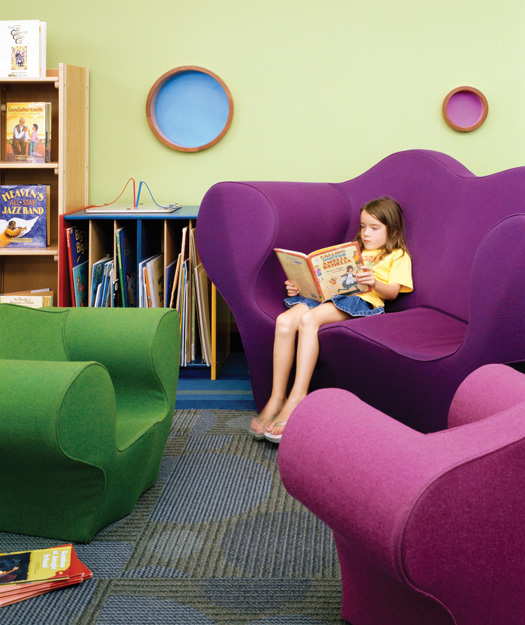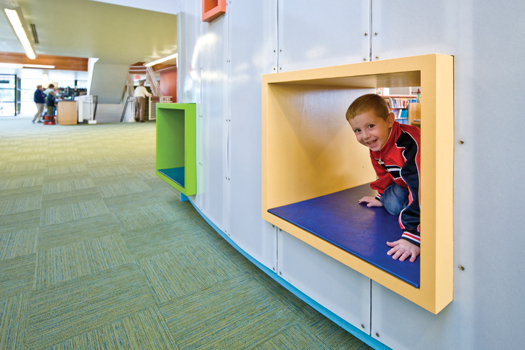How To Design Library Space with Kids in Mind | Library by Design, Fall 2012
When creating special spaces where children can experience joy in learning and investigation, public and school libraries often are inclined to produce primary-colored themed spaces that may appear on the surface to be kid-friendly. These spaces, however, can be a flat experience for children. Children appreciate good design, subtlety, and nuance. We should avoid talking down to them with the spaces we provide just for them.
By considering the following principles, libraries can create children’s areas that provide a layered experience that works for youngsters of many ages and that provides multiple ways for children to learn, interact with other children or their caregivers, and achieve a sense of accomplishment.
Provide layered experiences
Offer a variety of areas—active and quiet, social and private—that encourage a range of experiences with multiple levels of challenge for different ages and abilities. Use technology to teach and engage. Simple interactive installations such as projected art that responds to movement will stand the test of time and will be enjoyed by all age groups. Allow the space and activities to grow with the children and provide enough complexity to engage children on more than one level.
Create a beautiful building
Consider the aspects of space design that offer comfort and encourage learning, such as access to daylight, the use of natural materials, comfortable seating, and places that provide shelter (e.g., booths or nooks) and are composed of environmentally healthy finishes. Recognize that children appreciate those things, too.
Create simplicity, directness, and delight

Design your building to be easy for parents and caregivers to use by making the spaces interesting for children and offering both caregivers and children a place to rest the body, soul, and mind. Include comfort rooms where children can calm down, or nursing mothers can have a quiet, private space. Offer aspects of surprise to allow children to discover something new on each visit. Make the ordinary extraordinary. For example, set windows and doors at child height to signal the space is just right for them.
Allow children to fill in the blanks

Children are more sophisticated about design than adults often give them credit for. They are keenly observant and interested in their surroundings. Design to allow children to fill in the blanks rather than prescribing what they see or how they engage with a theme or literal interpretation. Children are among the few in our society who look up in a building, so give them something at which to look.
Offer paths to pride and accomplishment

Children thrive when accomplishments are visible and acknowledged. This accounts for the popularity of summer reading programs. Celebrate milestones both in learning and life.
Offer refuge within the building

Children need places where they can regroup to rest their eyes, their bodies, and their minds. These spaces can be pockets with soft seating and books or puzzles to settle in with or spaces with views to the outside.
Remember that kids need to move

Provide space where it is okay to do so, and set out fixtures that encourage movement and activity, while fostering imagination. For example, a play kitchen lets children use gross and fine motor skills.
Engage all the senses

Simply put, the more senses we use in a learning activity, the more we remember. Create a memorable experience by getting children to use their all of their senses—sight, smell, touch, hearing, and even taste. Positive memories will increase learning and the desire to return.
Create a sense of anticipation

The journey and path to the children’s area are just as important as the destination.
Create a beautiful building
Consider the aspects of space design that offer comfort and encourage learning, such as access to daylight, the use of natural materials, comfortable seating, and places that provide shelter (e.g., booths or nooks) and are composed of environmentally healthy finishes. Recognize that children appreciate those things, too.
Traci Engel Lesneski is Principal and Head of Interiors, Meyer, Scherer, & Rockcastle (MS&R) Ltd., Minneapolis
They encountered key areas that are important to consider and presented things to consider when archiving digital material.
Add Comment :-
RELATED
ALREADY A SUBSCRIBER? LOG IN
We are currently offering this content for free. Sign up now to activate your personal profile, where you can save articles for future viewing









